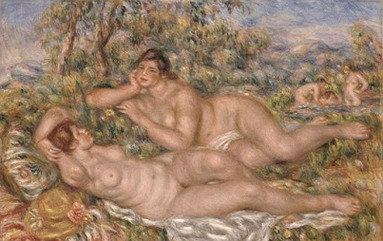Two exhibitions
dal 31/1/2013 al 4/5/2013
Segnalato da
31/1/2013
Two exhibitions
Fundacion Mapfre, Madrid
The exhibition "Impressionists and Post-Impressionists: The Birth of Modern Art" traces the evolution of the final years of the two movements through 78 great masterpieces. "Bohemian Lights: Artists, Gypsies and the Definition of the Modern World" explores presents approximately one hundred masterpieces by artists of the stature of Goya, Watteau, Gainsborough, Teniers, Corot, Delacroix, Courbet, Manet, Degas, Sorolla, Sargent, Signac, Van Gogh and Picasso, among others.

Impressionists and Post-Impressionists
The Birth of Modern Art
The exhibition Impressionists and Post-Impressionists: The Birth of Modern Art traces the evolution of the final years of Impressionism and the Post-Impressionist movement through 78 great masterpieces from the Musée d’Orsay.
In 1886, the Impressionist group held its eighth and final exhibition at the gallery run by the art dealer Durand-Ruel. Over the course of eight legendary shows, these artists had blown the traditional conception of painting to smithereens. Critics and the public were starting to assimilate the stylistic novelties, and the Impressionists had begun to make a name for themselves. Thus, between 1886 and 1900 a more profound and radical modernity was able to develop. Impressionism evolved towards different pictorial approaches, traditionally defined as Post-Impressionist but which actually expanded on the provocative aspect of Impressionism, defining the stylistic principles that would pave the way for the languages of the 20th-century avant-gardes.
The exhibition opens with Monet’s early series (Haystacks, Poplars and Cathedrals) and ends with the decorative works of Vuillard in his Public Gardens. The path between these two markers is lined with Renoir’s works on the theme of bathers, pieces by Seurat, Signac and Pissarro that document the rise of Neo-Impressionism, the Constructivism of Cézanne, Toulouse-Lautrec’s portrait of the underworld, the escape of Gauguin and his friends to Brittany, the work of Les Nabis, exemplified by Sérusier, Maurice Denis, Bonnard and Vallotton, and Van Gogh’s descent into madness in Arles.
This exhibition has been organised with the scientific collaboration and exceptional loans of the Musée d’Orsay.
General curatorship
Guy Cogeval, President of the museums d'Orsay and l'Orangerie
Pablo Jiménez Burillo, Director of the Instituto de Cultura, FUNDACION MAPFRE
Scientific curatorship
Caroline Mathieu, Chief Curator Musée d’Orsay
-----
Bohemian Lights
Artists, Gypsies and the Definition of the Modern World
Bohemian Lights: Artists, Gypsies and the Definition of the Modern World explores the origins of artistic Bohemianism and how it is connected to the representation of gypsies in art through approximately one hundred masterpieces by artists of the stature of Goya, Watteau, Gainsborough, Teniers, Corot, Delacroix, Courbet, Manet, Degas, Sorolla, Sargent, Signac, Van Gogh and Picasso, among others.
The concept of artistic Bohemianism emerged in the mid-19th century, halfway between Romanticism and Realism. From that moment on, the artist’s creative freedom became paramount, even though—or perhaps because—it often entailed professional failure and social marginalisation. Paintings, literature, the press, songs, operas and films told the tales of talented youths who chose to lead lives of abject poverty rather than betray their lofty artistic ideals. These narratives drew on the conventional imagery associated with gypsies and vagabonds, who shared the artist’s need for an unfettered, authentic existence. Thus, the Bohemian lifestyle grew into one of the great legends of the modern era.
This legend is part of the rich, complex history of the Bohemians—travelling gypsy races—whose nomadic existence has been stereotyped in the history of art and literature as the symbol of a lifestyle unfettered by rules, ties or bourgeois conventions. Thus, when many young artists flouted the rules and were rejected by the academic system in the mid-19th century, they fled to the garrets and taverns of Paris. Sure of their talent but misunderstood by the critics, they suffered the same fate of marginality and poverty as the gypsies, and little by little this lifestyle came to be revered as a prerequisite for artistic and spiritual freedom.
Thus, in the 19th century, gypsy and artistic Bohemianism became the favourite models of Bohemian creators, who sought to portray the world and themselves in that alterity. This exhibition explores that shared history, highlighting the points of convergence and divergence between those two “Bohemianisms” and the role they played in shaping the modern world.
This exhibition has been organised by FUNDACIÓN MAPFRE, Madrid, and the Réunion des musées nationaux - Grand Palais, Paris
General curatorship
Sylvain Amic and Pablo Jiménez Burillo
Chief Curator, FUNDACION MAPFRE
María López Fernández
Director of Exhibitions, FUNDACION MAPFRE
Nadia Arroyo Arce
Image: Auguste Renoir, Les baigneuses 1918 - 1919. Oil on canvas.
Musée d’Orsay, Paris © RMN-Grand Palais (musée d'Orsay) / Hervé Lewandowski
Press contact:
Alejandra Fernandez t +34 91 5818464 alejandra@mapfre.com
Opening: 1st february, 8pm
Fundacion Mapfre
Paseo de Recoletos 23 - Madrid - 28004
Monday 14.00 a 20.00
Tuesday - Saturday 10.00 a 20.00
Sunday 11.00 a 19.00.
Free entrance



